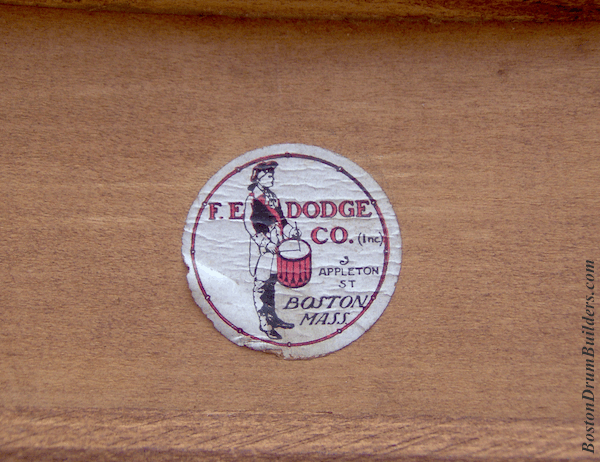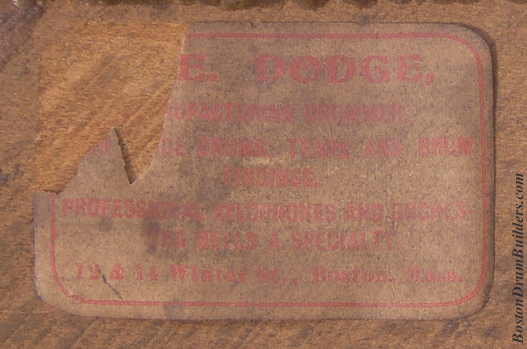A website devoted to Boston's early 20th century drum makers
F. E. Dodge Co.
Background • Catalog • Badges and Labels • Examples • blog
BACKGROUND
Frank Edward Dodge was born on July 10th, 1877 in Wenham, Massachusetts. By the 1890s his family had relocated to Boston where he received his primary schooling at Boston's English High School graduating as a member of the fourth year class in 1896. He continued his education at the Massachusetts Institute of Technology between 1896 and 1901 studying Mining Engineering, Mechanical Engineering, and Chemistry. By 1901 Dodge was performing regularly in Boston's thriving theater scene where he was frequently a featured xylophone soloist. Around this time he also began manufacturing drums at 12-14 Winter Street, the same address where his father was employed at the Boston Stitching and Plaiting Company.
The F. E. Dodge Company was incorporated in 1903 and continued until 1912 when the business was taken over by Nokes & Nicolai. Sometime around 1903 Dodge bought out William J. Blair, formerly of Blair & Baldwin, who then continued to work for the F. E. Dodge Company. By January of 1904 the F. E. Dodge Company was located at 3 Appleton Street in Boston and employed ten workmen in addition to Frank and his younger brother Harry who served as the factory superintendent. The brothers took great pride in the fact that they and all of their employees were not only manufacturers, but also performing musicians and members of the local Musicians Union.

Following Frank E. Dodge's death in 1918, the "Dodge Drum School" was revised and enlarged by Boston Symphony percussionist Carl E. Gardner and republished by the Columbia Music Company of Boston. The "Dodge Drum Chart" was later re-arranged and edited by George Lawrence Stone and published by George B. Stone and Son in 1928, a testament to the worth of Dodge's systematization of rudimental patterns.
Dodge was also an active teacher from the early 1900s until his passing at age 41. In his later years he was an instructor for the Mrs. Oliver Ames Senior Band in North Easton, Massachusetts and an instructor for the Army and Navy band school at Boston's New England Conservatory of Music. Dodge's most famous pupil was George Lawrence Stone, son of George Burt Stone who owned and operated Geo. B. Stone & Son. Frank Dodge must have had a very good relationship with the Stones as he thanks "Drum Major George B. Stone" in his introduction to the Dodge Drum School and shared the stage with George Lawrence on many occasions including for several seasons with the Boston Opera Orchestra.
CATALOG
Advertising material and other ephemera from the F. E. Dodge Company is scarce due to the company's age, relatively small size, and fairly short life span. A few examples, however, do survive. The 1907 F. E. Dodge Company catalog lists a diverse array of percussion instruments ranging from timpani to orchestra bells to drums for all purposes in addition to all of the traps, small instruments, and accessories a drummer would have needed, regardless of his specific area of expertise. Various snare drum models ranging in size from as small as 3" x 14" up to 16" x 10" were listed.

Snare drum shells were predominantly wooden, typically constructed of one ply maple with reinforcing rings. "Seamless Silver Aluminum" shells were available in small orchestra drum sizes as described in the 1909 printing of the "Dodge Drum School".

Frank E. Dodge was an accomplished rudimental drummer in his younger days as a member of the First Regiment Drum Corps. He was also an experienced classical percussionist performing as timpanist with the Boston Festival Orchestra and the Boston Opera Orchestra where he would eventually become manager. In 1904 he was a featured soloist with Stewart's Boston Band during performances at the Worlds Fair in Saint Louis and was scheduled to join John Philip Sousa's band the following season, a position which he ultimately declined out of obligation to his manufacturing business.
Dodge also penned two widely used early 20th century instructional resources, the "Dodge Drum Chart" in 1908 and the "Dodge Drum School" in 1909. While the earlier of the two texts dealt only with rudimental drumming, the "Dodge Drum School" was a more comprehensive method book containing introductory material for bells, xylophone, and timpani as well as musical examples for many of the drummer's 'traps' including tambourine, triangle, castanets, sleigh bells, whip, anvil, and even coconut shells. Dodge stopped short of writing a complete method for all of the instruments stating in his introduction that "It is quite impossible to go very far into the Bells, Xylophone, and Tympany in a Dollar Method, and for that reason I intend to publish methods for these instruments separately."
EXAMPLES





F. E. Dodge Snare Drum
(ca. 1902 - 1903)
This is a very early F. E. Dodge Orchestra Drum, dating from before the incorporation of the F. E. Dodge Company in 1903. The heads are tensioned by way of 18 single tension rods which adjust both heads simultaneously.
F. E. Dodge Co. Orchestra Drum
(circa 1908 - 1909)
This drum represents the larger of the two cataloged orchestra drum sizes, 4" x 15". The shell is one ply maple with maple reinforcement rings and sports a polished rosewood grommet lining the vent hole.
An updated strainer design is stamped "PAT APL'D FOR" though it appears that no patent was ever granted for this particular design. The F. E. Dodge Co. badge is installed on the top counterhoop, a feature not seen on earlier examples.
F. E. Dodge Co. Thumbscrew Model Snare Drum
(circa 1909 - 1912)
This single tension thumbscrew model is simple by design but the way in which the tension rods attach to the top hoop are revolutionary. This is one of the earliest, if not the first, uses of a true swivel nut. Each top claw is hollow, formed from stamped metal and houses a free swiveling nut which accepts the tension rods and pulls against the hoops thus tuning the heads.
Drums using these swivel nut claw hooks are nowhere to be seen in the 1907 catalog but are depicted in the 1909 printing of the "Dodge Drum School". This presumably places the introduction of this model and other drums using the same style claws to 1908 or later.
F. E. Dodge Co. Orchestra Drum
(ca. 1904 - 1907)
The 1907 Dodge Drum catalog lists the Orchestra Drum in two sizes including the 3" x 14" model represented here. The claws connecting the tension rods to the wooden hoops are quite innovative and are unique to Dodge. Each claw utilizes a primitive swiveling design which allows the tension rods to float either slightly closer to or further from the shell. They are not true swivel nuts however as they do not allow for side to side movement. For more on this drum, please visit http://blog.bostondrumbuilders.com/2016/11/ca-1907-f-e-dodge-orchestra-drum.html
F. E. Dodge Co. Rod Tension Street Drum
(ca. 1904 - 1907)
So called 'street drums' are large instruments intended for military style performance applications. Traditionally these would have been rope tension drums tuned using leather tugs. This example instead utilizes Dodges "double straining snare drum rods".
For more on this drum, please visit http://blog.bostondrumbuilders.com/2017/01/f-e-dodge-field-drum-ca-1904-1907.html
BADGES and LABELS

(click to enlarge)
A very late F. E. Dodge label found inside of a Nokes & Nicolai snare drum circa 1912.

photo: Jim Davey
This uncommonly seen badge was found on a pair of aluminum shell Dodge timpani dating from the early 1900s.

(click to enlarge)
The small version of the F. E. Dodge label, measuring only 1 1/8" across, was used on smaller instruments such as shallow depth snare drums. Note the lettering "(Inc.)" added to this label which is not present on the previous example. The F. E. Dodge Company was incorporated under Massachusetts law in 1903 and later dissolved in 1907. The handwritten "(Inc.)" notation may date instruments with this label to that period.

The F. E. Dodge Co. badge frequently appears mounted to the batter side hoops of snare and field drums. It was also used on the outside of bell and xylophone cases and even on some large 'traps' such as boat whistles.

(click to enlarge)
This F. E. Dodge Co. label is commonly seen on instruments from the first decade of the 1900s. The large version of this label, measuring 3" across, was used for larger instruments such as bass drums, and field drums. It was also sometimes fixed to the inside of xylophone and glockenspiel cases. Oddly, both the large and small round labels (seen below) are often applied to the inside of snare drum shells upside down across from the air vent.

(click to enlarge)
A very early F. E. Dodge drum shell label predating the F. E. Dodge Company's incorporation in late 1903. The address listed here is 12 & 14 Winter Street, Boston, Mass. Also note that it reads "F. E. Dodge Manufacturing Drummer", not F. E. Dodge Co.